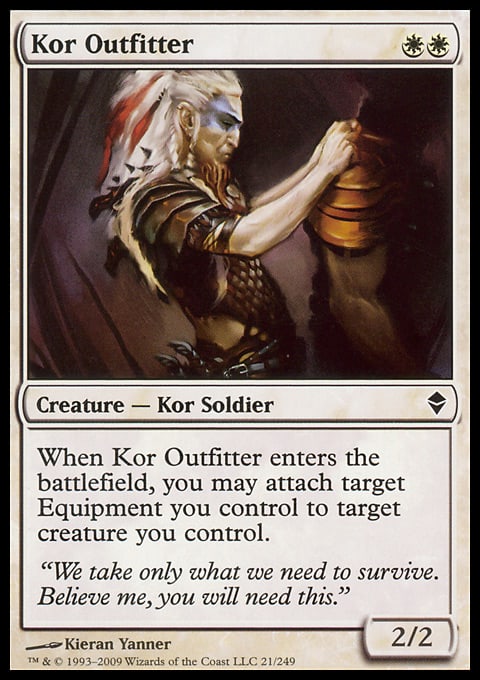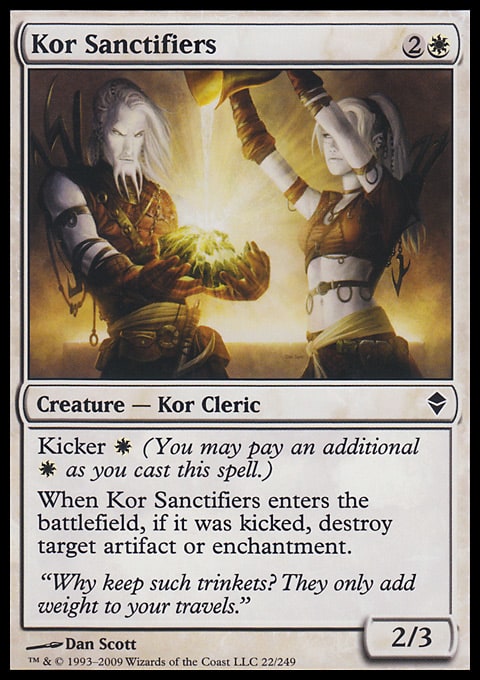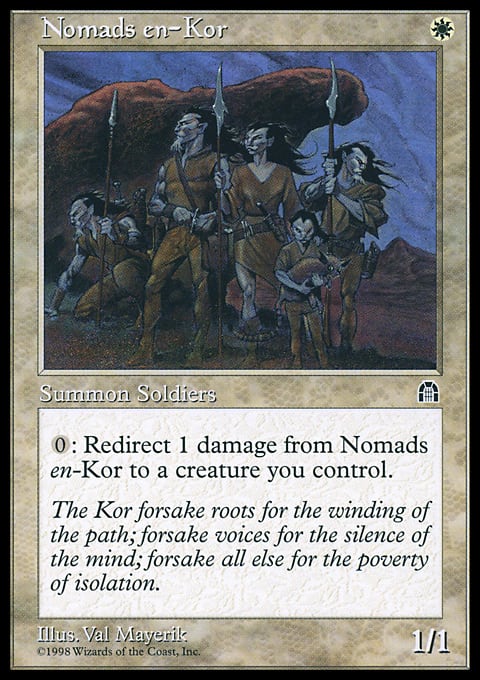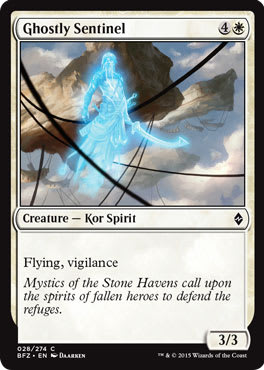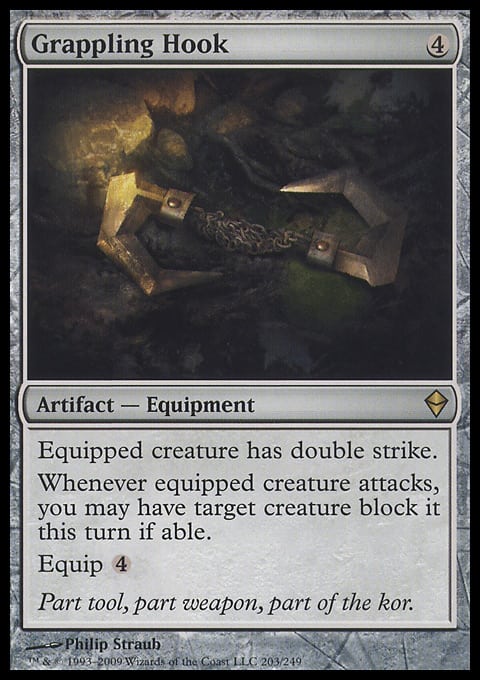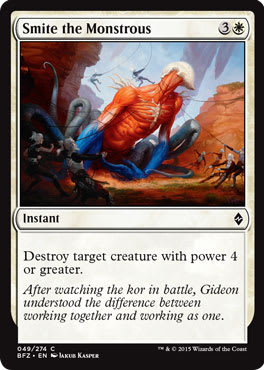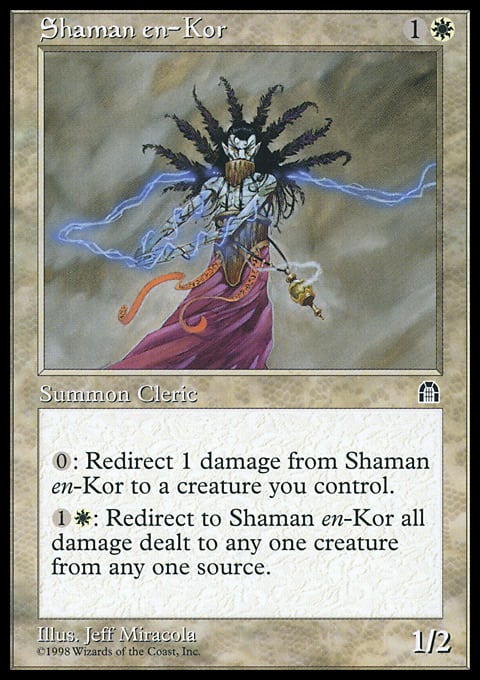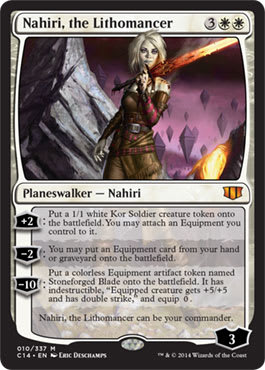If I want to read about my favorite games, I simply visit sites dedicated to them for quality community-created or officially-released content. When I was a kid, it was not so easy. Back in the day, if you wanted to read articles about something like Dungeons & Dragons, you needed to drive to the store and pick up a magazine dedicated to either the game or the genre is was a part of.
Dragon Magazine was one such resource for young Ant, and the day it would arrive each month was always a highlight. One of my absolute favorite features of that magazine was a running miniseries of articles entitled “Ecology of the [blank].” In each installment, the writer would focus on a single race prevalent in Dungeons & Dragons and do a deep dive into the rich history, physiology, and culture of that particular race.
I am going to try out that approach with one of Magic's races, one whose current plight is firmly centered in the spotlight. Today, I present to you the ecology of the Kor.

To date, the Kor have been known to exist on three planes. Originally from Zendikar, the Kor were transported to the artificial plane of Rath prior to its overlay onto the plane of Dominaria. As I go through each section of this article, I will be dividing information by those three planes, as the cultures, tactics, and psychologies of the Kor differ with the worlds they inhabit.
History of the Kor
Zendikar
Here is the Kor home world. Zendikar is a tumultuous plane rich in mana and danger. While living on Zendikar, the Kor have experienced many large-scale events that would have shaped them into the resolute people we know today.
They existed on Zendikar long before the Eldrazi were ever imprisoned there, as Nahiri (one of the Planeswalkers who worked to lock away the titans on the plane) is a Kor. This means the Kor as a people once knew a Zendikar free of both any Eldrazi titans and any hedrons.
At some point after the Eldrazi were first lured to Zendikar, the Kor began worshiping the titans as gods under the names Kamsa, Mangeni, and Talib. The Kor were there when the Eldrazi broods first broke free and were then subsequently resealed by Nahiri. They were alive when the Eldrazi broke free a second time, have come to recognize that their gods are a lie, and exist now as a few remaining souls fighting the Eldrazi and Ulamog for their home.
Now that the threat of total annihilation is imminent, the Kor have begun accepting allies of all races in their fight against the Eldrazi threat. Where they used to be tightknit bands, the Kor are now a part of a multicultural, multiracial army. Always finding a way to survive, a few resourceful Kor have turned toward an existence underground in hopes of avoiding the Eldrazi threat above.
Rath and Dominaria
At some point during the events on Zendikar, a large group of Kor were ripped from their world entirely and deposited on the artificial plane of Rath. Some Kor were not as lucky as others, and in the process of being transported to Rath, they were trapped in a shadowy “between-worlds” state, unable to interact with the material world. Those who made it to Rath unscathed found themselves to be planar refugees and quickly fell into two major groups: the en-Kor and the il-Kor.
The en-Kor are those of the race who remained with the tribe, dwelling in the open plains of Rath while taking up residence in the stone-carved Kor Haven. Similar to their lives on Zendikar, the en-Kor lived a nomadic existence and fostered a deeply spiritual culture.
The il-Kor were traitors to their tribe, either cast out or as willful objectors who would find their way to the City of Traitors under the rule of Volrath, the current Evincar of Rath. Abandoning the ways of the nomad, these Kor would use their skills to become thieves lurking in dark alleys of hunters prowling city streets.
When the false plane of Rath underwent the overlay with Dominaria during the Phyrexian Invasion, the Kor were taken along for the ride. The en-Kor continued on as nomads, finding their adoptive Rathi lifestyle translated well to the open plains of Dominaria.
The il-Kor were not so lucky, most still being trapped in their shadow state. Ever resourceful, these Kor decided to make the best of a bad situation and began to use the shadow state to their advantage, working as informants and spies.
Physiology of the Kor
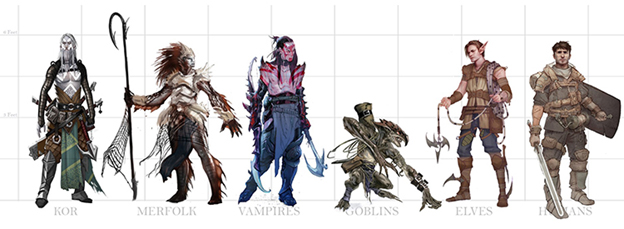
Being that all known Kor originated from Zendikar, they all exhibit a similar physiology to one another. All Kor have light blue to white skin with hair that ranges from stark white to a deep, almost black-blue color. Kor exhibit an average height for most humanoids, being shown to compare evenly with the vampires and humans of Zendikar at around six feet tall. The race was concepted to have lithe silhouettes with thin faces that give them a streamlined and athletic look.
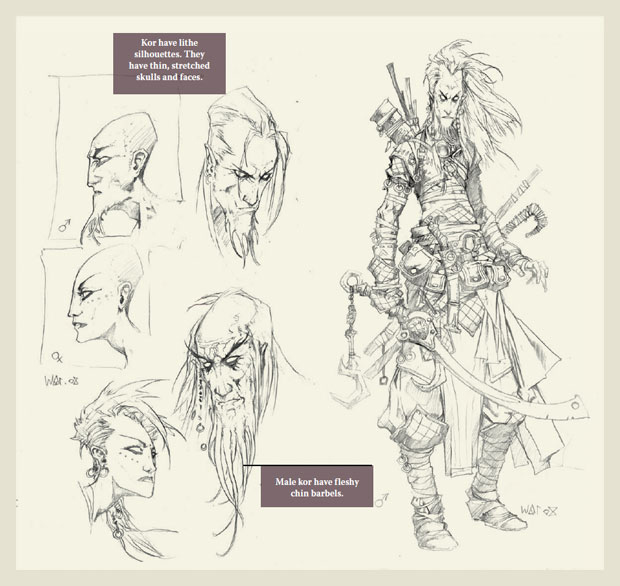
"The Look of Zendikar" | Sketch by Wayne Reynolds | Article by Jeremy Jarvis
A notable feature found on male Kor are fleshy barbels seen growing around the mouth and chin. These whiskerlike growths function as sensory organs and are akin to those found on some fish. In most fish, the barbels house taste buds and are used to search for food in murky water. How Kor barbels function is a mystery. Being that the Kor are usually found living in the open planes, perhaps the barbels are used to “taste” the wind as a way to find and acquire food.
Zendikar
Zendikari Kor are fiercely nomadic in nature; they travel light and are rarely found without some form of hook and/or rope. A notable marking found only on the Zendikari Kor are large tattoo-like markings styled after hedron symbols. If you encounter a Kor with such markings in your travels, chances are they originate from Zendikar.
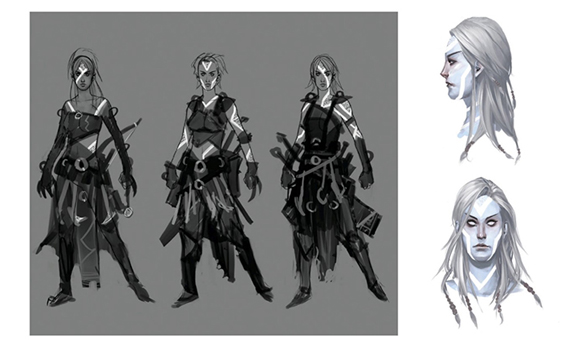
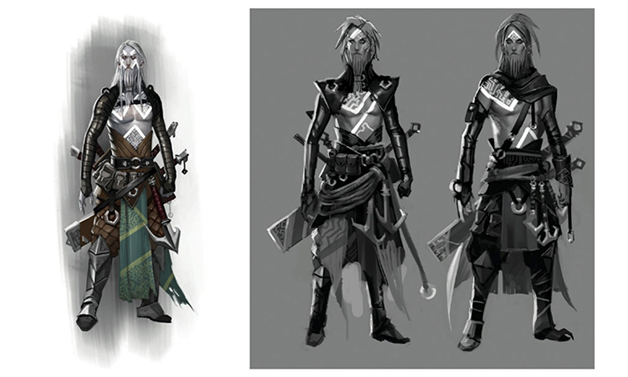
Sketch from “Eldrazi, Humans, and Kor, Oh My!” | Article by Michael Yichao
Kor from Zendikar core commonly are shown as having white skin and white hair, with the possible darker colorations being less prominent.
Rath and Dominaria
These Kor lack the hedronesque markings of their Zendikari counterparts and are often dressed in a more traditional desert nomad style. Kor found on Rath and Dominaria seem to exhibit the darker coloration of the Kor more frequently, as most have a deep black-blue coloring, and the deeper skin tones are more prevalent as well.
Psychology and Society of the Kor
Whether they are found on Zendikar, Rath, or Dominaria, the Kor are a deeply spiritual people, with religious beliefs often centering around the wind, air, and wide open lands. Kor also tend to be nomadic and rarely settle in any one place for too long.
Zendikar
Zendikari Kor do not believe in “settling down,” but that does not mean that they have no sacred places or revered areas. Many Kor used to make pilgrimages from one sacred location to the next prior to the emergence of the Eldrazi. The Kor are “doers,” not “sayers.” If a Kor thinks something needs to get done, he or she will just get it done—and will expect the same from you.
The Kor are also resolute. They believe there is a solution to every problem. This makes me think of something my first boss used to say to us: “Never come to me with a problem and say, “I can’t.” Instead, come to me and say, “I can if . . . ”” The flavor text on Kor Firewalker exemplifies this idea. For the Kor, obstacles do not remain as hindrances for long.
Kor place an increased sense of value on individual skill. They do not believe in the use of technology to compensate for lack of ability. You won’t see a Kor wielding a crossbow. If a Kor falls in battle, it will be because he or she lacked the skill to survive, not because his or her weapon malfunctioned. However, in almost contrast to this belief in strong individual ability, the Kor also understand the power of community. It is this reason the hook and line are so important to the Kor people. While the items serve as useful tools and powerful weapons in the right hands, they also represent the binding ties of loyalty holding each community together.
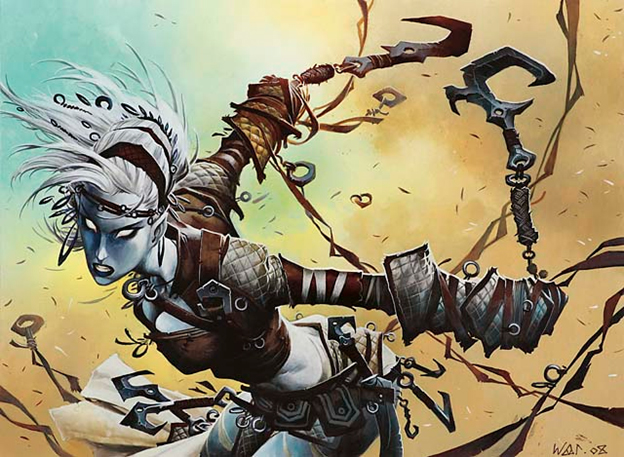
"For us, a rope represents the ties that bind the kor. For you, it's more literal."
Before the three Eldrazi titans Emrakul, Kozilek, and Ulamog were revealed to be the world-devouring cosmic horrors they are, the Kor worshiped the three entities as gods. Over time, the tales surrounding the three formed a religion based around different aspects of nature.
Now the Kor find themselves fighting back against this false pantheon as their gods Kamsa, Mangeni, and Talib have revealed themselves to be the Eldrazi titans Emrakul, Ulamog, and Kozilek. Some Kor still worship the titans as gods and can be found making pilgrimages in the wake of Ulamog. Others have replaced their faith in gods with a faith in each other. The kor lost their religion but are no less spiritual.
Central to their religious beliefs were close relationships with nature and the land itself. While their belief in gods has come and gone, this understanding of the importance of nature is something that has forever been central to their race. One instance when this spirituality manifests itself is in the “world-gift” tradition.
The Kor also share a belief in the power of twins working in concert with one another. This ideology manifests itself in the Kor of multiple planes. As seen in the flavor text of Kor Entanglers, the Zendikar Kor twins consider themselves to be one complete being that functions in unison and will live and die together.
Rath and Dominaria
The Kor of Rath showcase a similar importance being placed on twins, as the flavor text on Lancers en-Kor showcases. Twins are trained to work in unison with one another. The idea is the same, just applied to a different combat style more applicable to life on the open plains.
The Kor of Rath and Dominaria are no less spiritual than their Zendikari brethren, having belief systems that also tie into the natural forces that surround them. They are a people who believe in the strength that comes from existing as one with the elements, drifting through the world in concert with the winds. The flavor text found on the Stronghold card Cloud Spirit further suggests spiritual beliefs surrounding the sky and elements.
The Kor of Zendikar still revere the spirituality found in nature, even after the realization that their three major gods were a lie. The Kor of Rath and Dominaria also revere the elements but do not seem to tie them to any major deities. This suggests that the Kor were deeply spiritual nature-worshipers before the Eldrazi were ever imprisoned on Zendikar.
These Kor are also just as optimistic and determined as their Zendikari counterparts. Remember that the Kor are not one to sit around and mope about their situation; they analyze and adapt. When they found themselves on a new plane, they adapted to the world around them, becoming fierce, mounted warriors of the open and unshifting plains. Kor who found themselves trapped in the shadowy between-world state used their new powers to become skilled informants, turning a bad situation into a beneficial one.
Kor Weaponry, Magic, and Tactics
Zendikar
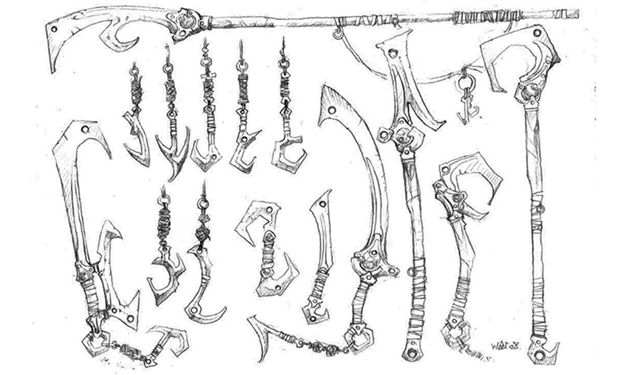
On Zendikar, weapons are ruled by their practicality. Blades need to serve more purposes than only slicing, and so hooks are a favored item for the cliff-threading nomads found among the plane’s constantly shifting topography. The Kor know they need to be ready for anything, and they go out of their way to ensure equipment can serve multiple purposes.
The hook-and-rope combination is the most important tool of the Kor—so much so that the tools carry significant cultural importance. Unique to Zendikari Kor are the use of kitesails as both a scouting technique and a combat strategy and the tradition of forging weapons from stone. Between their armorers, scouts, and hookmasters, a group of Kor can be a fearsome opponent to all but the mightiest of foes. Even though they prefer to make use of these group tactics, a single Kor is never to be underestimated, as they are skilled combatants able to use their opponents’ strengths against them.
Rath and Dominaria
One thing that separates the Kor of Rath and Dominaria from the Zendikari is the use of trained mounts in place of ropes and hooks. This is most likely due to the fact that unlike Zendikar, Rath and Dominaria had vast open plains of flat and unshifting terrain that requires long rides as opposed to vertical climbs. Adapting to this new environment, the Kor have come to understand that a rope less value in flat and unchanging lands than it did in the shifting verticality of their home world. The lance and spear are then obvious choices of weaponry, as they can be used in mounted combat.
Another notable difference seen in the Rathi Kor is an increase the use of magic to defend themselves. Where the Zendikari Kor rely on their reflexes and skill with a rope to survive, the Rath- and Dominaria-native Kor depend on their ability to magically reflect their opponents’ attacks against them. This reflection magic seems to have a more shamanistic quality to it than the healing magics of Zendikari Kor. Shaman en-Kor is the only Kor shaman. All other spellcasters are clerics and wizards.
Notable Kor
Nahiri, the Lithomancer
Nahiri is a powerful female Kor stoneforger and Planeswalker from Zendikar. She is one of the three Planeswalkers responsible for luring and trapping the Eldrazi titans on Zendikar, and she spent forty years constructing the hedron network seen throughout the plane. We last saw her planeswalk away from Zendikar after quelling an uprising of the Eldrazi broods. Nahiri’s current whereabouts are unknown.
Akiri, Kor Line-Slinger
Akiri is a Zendikari Kor quoted on two cards from Battle for Zendikar. The epithet of “Line-Slinger” suggests that this Kor specializes in the use of ropes and hooks in battle, most likely in similar fashion to the card Kor Line-Slinger.
Munda, Ambush Leader
Munda is also a Zendikar native and is known by many by the epithet of “the spider.” He is called this due to his specialization with the hook and rope and his ability to weave them while in battle. Munda was last seen serving as a squad leader under the command of the Planeswalker Gideon Jura as they fought to retake Sea Gate.
Tars Olan, Kor World-Gift
As implied by this Kor’s epithet, Tars is a Kor who survived being offered to Zendikar under the World-Gift tradition. Because of this, Tars has a strong belief in the latent potential of the individual and the individual’s ability to overcome great obstacles in the face of death (as seen in his quote on the card Smite).
Rana Cloudwake, Kor Skyfisher
Before hunting the Eldrazi, the Kor used to hunt mikunga, a species of flying eel native to Zendikar. Rana’s epithet and quote on Windrider Eel leads us to believe that this Kor was one such hunter, fishing the skies for the slippery prey.
TL;DR
The Kor as a people are nomadic and deeply spiritual, and they emphasize the importance of both individual strength and working as a community. They have been ripped to foreign worlds, they have worshiped false gods, and they currently face the total annihilation of their home world. Though all of that hardship, one thing remains: The Kor are tough and not to be taken lightly.
I hope you enjoyed this deep dive into the Kor. Would you like to see more “Ecology of the [blank]” articles like this one? Let me know in the comments below.
Until next time, take a lesson from the Kor and support your local community.
-Ant
















